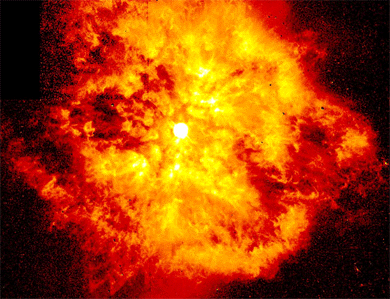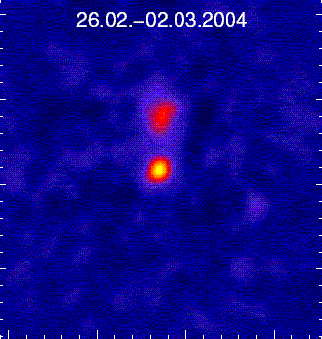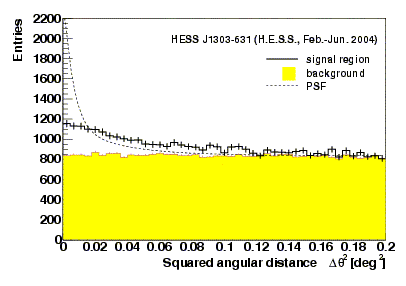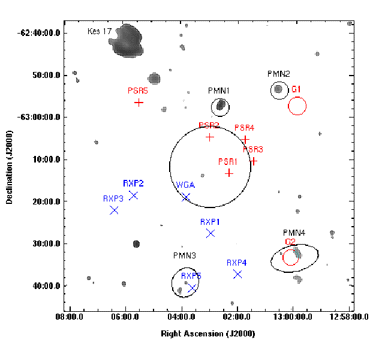HESS J1303-631 - the mystery TeV source
May 2005

Observations of the binary pulsar PSR B1259-63 reveal, apart from a clear TeV gamma ray signal from the pulsar, a big surprise: a second source of TeV gamma rays about 0.5o north of the pulsar (Fig. 1). In distinction to the time-variable signal from the pulsar, this second source appears steady. The image of the source is significantly wider than the well-understood point-spread function of the H.E.S.S. instrument, indicating an extended source (Fig. 2). Assuming a Gaussian source profile, the (rms) source width is estimated to 0.16o. Both the source extension and its location - within 0.5o from the Galactic plane - argue for an object in our Galaxy. However, there is no obvious counterpart in other wavelength regimes, with which the source could be identified. Many such unidentified sources appear at lower energies in the EGRET source catalogue (Hartman et al. 1999), but there the reason is partly given by the poor angular resolution of EGRET, which makes it difficult to uniquely identify a counterpart. At TeV energies, only one such source without obvious conterpart is known, detected by HEGRA (Aharonian et al. 2002). All other TeV sources found so far can be associated with well-known objects such as active galactic nuclei or supernova remnants. The new source, named HESS J1303-631, exhibits a power-law energy spectrum, measured between 0.5 TeV and 10 TeV, with a photon spectral index of 2.4 and a flux of roughly 17% of the flux from the Crab Nebula. The exact source coordinates are 13h3m3.4s+-4.4s, -63o11'55"+-31".
Various possible explanations for the origin of the gamma rays have been discussed. The lack of strong X-ray or radio signals from the region, i.e. the absence of prominent synchrotron radiation, suggest that this may be a proton accelerator, as opposed to the high-energy electrons which are dominant in many TeV sources and which provide a clear synchrotron radiation signature. Protons could e.g. be accelerated in the winds of OB stars (Montmerle 1979). Such stars have high-velocity outflows which could generate termination shocks when the wind pressure is balanced by the ambient medium, and in these shocks accelerate particles. HESS J1303-631 is indeed close to an association of OB stars, Cen OB 1 (Hartkopf et. al. 1999). The gamma rays could also be generated in pulsar wind nebulae, similar to the Crab Nebula or PSR1259-63. Several pulsars are know with positions close to HESS J1303-631 (Fig. 3). From the energetics point of view, however, none of the pulsars is a plausible counterpart, since the gamma-ray luminosity alone equals or exceeds their spin-down energy loss. One could also imagine a dense gas cloud illuminated by cosmic rays as the origin of the gamma-ray signal. A search in CO catalogs (Bronfman et al. 1989) yields enhanced densities of interstellar gas a various distances from Earth, but only a combination of such clouds with a local cosmic-ray source could generate the observed source profile and flux. Another potential explanation is radiation generated in the annihilation of dark matter accumulated in the halo of our Galaxy. In the hierarchical process of structure formation, dark matter clumps were generated, many of which may have survived until today (Moore et al. 1999). However, it seems unlikely that such a dark matter clump will generate such intense gamma-ray signals, and the angular distribution should be more strongly peaked. More sensitive follow-up measurements in the X-ray and radio regimes might help to pin down the physics of this new source.
References:
Serendipitous discovery of the unidentified extended TeV gamma-ray source HESS J1303-631, H.E.S.S. collaboration, F. Aharonian et al., A&A, in press


